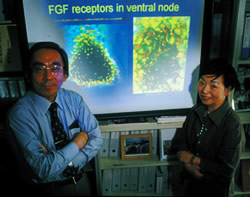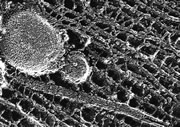| Biohistory journal,Autumn, 2005: Index >From the microscopic aspects of anatomy to the overall body |
| Observing movement From the microscopic aspects of anatomy to the overall body Nobutaka Hirokawa and Keiko Nakamura | |
| |
Fixation with a chemical is too slow for viewing phenomena occurring within a cell using an electron microscope. Therefore, I thought of freezing it instantaneously. Dr. Nakamura: I understand. Rapid freezing stops time in a cell in an instant, enabling one to see the flow of time. Stopping something enables one to observe movement. That’s interesting. Dr. Hirokawa: Anyway, what I wanted to see was the living cell. Molecules seen in a frozen photograph are indeed motor molecules, and recently we have understood their influence in controlling the body. The belief has emerged that movement determines the phenomena of life. Dr. Nakamura: Using cells as the basis links everything from molecules to the body. In addition, it is wonderful to understand that concept by observing it at every level. |
Observation, the theme of our discussion, is a word with a truly deep meaning, and I sensed Ms. Nakamura’s erudition and deep insight into the life sciences . There were points of great simpatico during our dialogue. First is the importance of research with its great inquiry into the phenomenon of life. I think the significance, depth, and breadth of research is due to “inquiry”. After that, one only employs every means to provide a solution to that inquiry. Next is the direction starting from the genome, through the cell to the molecular biology of the body. In my case, I advanced from the world of observation using optics and the electron microscope to the analysis of substances, genes, and function using biochemistry, molecular biology, and molecular genetics. From there I went to an analysis of the dynamic structure at the molecular and atomic levels using biophysics and structural biology. The points of departure were different, and the courses pursued were the reverse of each other, but our points of arrival were the same--we were able to observe the entire series from the gene to the cell, the body, and then to action. In a photograph taken with an electron microscope, all the actors that I wanted to see supporting the mechanism of dynamic substance transport in the core elements of the cell function were visible. But there still must be many actors that we do not yet understand. The more we know, the more questions arise. It is indeed a case of seeing yet not seeing at the same time. I want to see all of these dynamic phenomena. |
| Dialogue |
|
Please close a window with the button of a browser who are turning off Javascript. |

